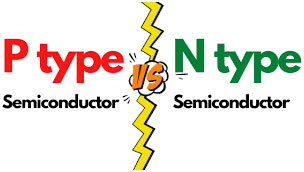N-type semiconductor
|
P-type semiconductor
|
| An n-type semiconductor is anintrinsic semiconductor doped by phosphorus (P), arsenic (As), or antimony (Sb) as an impurity. |
A p-type semiconductor is an extrinsic type of semiconductor. When a trivalent impurity (like Boron, Aluminum etc,) is added to an intrinsic or pure semiconductor (silicon or germanium), it is said to be a p-type semiconductor.
|
| The majority of charge carriers are free electrons while the holes are in minority in an N-type semiconductor
|
The majority of charge carriers are holes while the free electrons are in minority in a P-type semiconductor. |
| To increase the number of electron impurities is added inn-type semiconductors These are well-known as Donar atoms. |
To increase the number of holes impurities are added in a p-type semiconductors. These are well-known as Acceptor atoms.
|
| The electrons density is higher than the density of the holes. (ne >> nh) as compared to the p-type semiconductor
|
The hole’s density is higher than the electrons density (nh >> ne) as compared to n-type semiconductor |
| The donor level generally lies nearer to the conduction band.
|
The accepts level generally lies nearer to the valence band. |
| The concentration of majority charge carriers is more as compared to the p-type semiconductor
|
The concentration of majority charge carriers is more) as compared to the n-type semiconductor |
